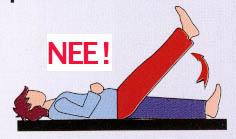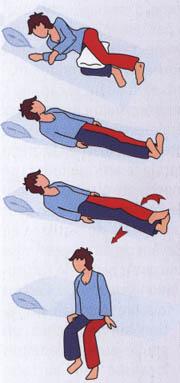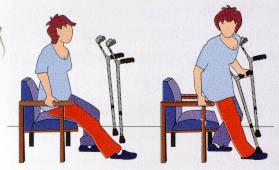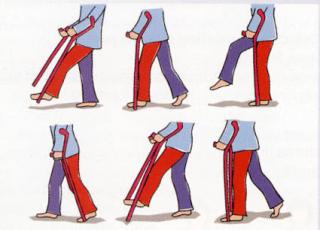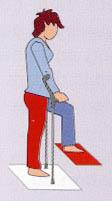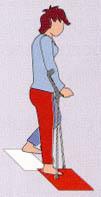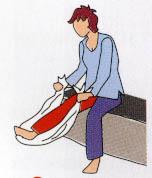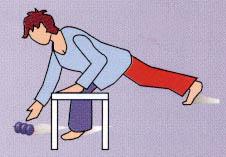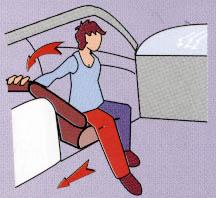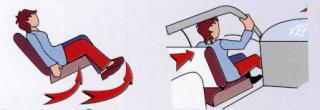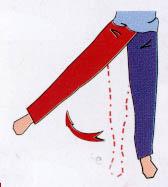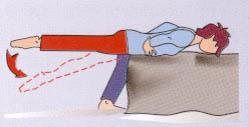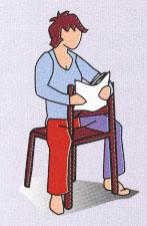Postoperative exercises
Overview of postoperative exercises
General guidelines and advice to follow emmediately postoperatively and during the first weeks.
Avoid rotational movements of the trunk (this is the forced rotation, in bed or standing, of the upper half of the body with support on the operated leg).

Never stretch the the operated leg stretched straight ahead when laying down (ie no Straight Leg Raising).
Crossing the legs is also discouraged during the first weeks after the operation.
The physiotherapists and occupational therapists will accompany you during your stay in the hospital.

In bed
 In the hospital you will be advised to sleep on your back. The operated leg is in a gutter to ensure a position that is as comfortable as possible. Once at home, sleeping on the back is recommended. Many people difficultly endure and prefer to sleep on their side. If you wish to sleep on the side, do not do this on the operated side and make sure there are 1 or 2 pillows between the legs to keep the legs apart.
In the hospital you will be advised to sleep on your back. The operated leg is in a gutter to ensure a position that is as comfortable as possible. Once at home, sleeping on the back is recommended. Many people difficultly endure and prefer to sleep on their side. If you wish to sleep on the side, do not do this on the operated side and make sure there are 1 or 2 pillows between the legs to keep the legs apart.
Getting out of bed:
You come straight out of the bed via the non-operated side (ie you have been operated on the Li leg then you come out of the bed via your right side). Place your leg as close as possible to the edge of the bed. Slide the non-operated leg under the operated leg and lift it gently. Turn the body in block so that you are sitting with the legs hanging on the edge of the bed. Then take support on the non-operated leg (with or without crutches) and try to keep the operated leg slightly stretched while standing up
To lay down in bed:
Sit down on the edge of the bed where you take support on both hands. Hook the operated leg with the non-operated leg and then move both legs in a block.
If you have a low bed at home, you can easily increase it by placing phone books under the legs of the bed or putting a second mattress on the bed.
Sitting:

Choose a good seat or seat. Make sure that it is steady with a relatively high seat with straight backrest and armrests. So no deep low seat.
To sit down:
Stand up with your legs against the chair or seat. Sit down and take support on the arms to slow down the sagging of the seat. Keep the operated leg almost stretched.
To stand up:
Take support with the arms on the armrest and use the non-operated leg to straighten while keeping the operated leg stretched.
Standing
When you change direction or you turn around, do not turn on the operated leg: when you have operated on the right leg, turn left to change direction.
Avoid standing still for a long time and divide the body weight over both legs when you are supported by 2 stools.
Gait with 1 or 2 crutches
Depending on the type of prosthesis, the age, the condition before the operation, the general fitness, you will have to go through 1 or 2 crutches for a very short to a slightly longer period.
How do I adjust my crutches well?
Adjust the crutches at the correct height. The elbow is best folded 30 degrees so that the arm muscles can work so more powerful. The handle should be aware of the hip (this is about the height of the bony protrusion that you can feel on the side of the thigh called trochanter).
How do I use my crutches while walking?

When standing with the 2 crutches you take support on the non-operated leg. Place both handles at the same time about half a meter in front of you. Support on both crutches and bring the operated leg forward and place the foot on the floor without fully supporting it. Then apply the non-operated leg. Then divide your weight over both crutches and the non-operated leg. Then repeat the cycle.
When using 1 crutch: Hold the crutch on the unoperated side and move the crutch together with the operated leg.
How do I go up and down stairs with crutches?
 Stairs up: Take step by step in three times
Stairs up: Take step by step in three times
Phase 1: Bring the non-operated leg to the top step by taking support on the crutches. Tool for this: 'you are ascending to heaven' (you start with the healthy leg, the good leg).
Phase 2: Take support on the non-operated leg and bring the operated leg at the same time as the crutches.
Phase 3: Both feet and the two crutches are now on the same step. Now repeat the movements until you are above.
 Stairs down: Take step by step also in three times
Stairs down: Take step by step also in three times
Phase 1: Place both crutches on the lower step where you take support on the non-operated leg.
Phase 2: Lower the operated leg with the crutches. Tool for this: 'you descend to hell' (you start with the operated leg, the so-called bad leg)
Phase 3: You add the non-operated leg. Both feet and the two crutches are now on the same step. Now repeat the movements until you are down.
Washing
 Choose a shower over a bathtub. In the shower you can use a simple plastic chair. It can be useful here to lay an anti-slip mat in the shower or bath. In any case, it is safer to wash yourself while sitting. In the beginning, a hairdryer can be easy to dry or a large towel.
Choose a shower over a bathtub. In the shower you can use a simple plastic chair. It can be useful here to lay an anti-slip mat in the shower or bath. In any case, it is safer to wash yourself while sitting. In the beginning, a hairdryer can be easy to dry or a large towel.
Putting on socks and shoes
Closed shoes that fit well, are sturdy and are provided with an anti-slip sole are recommended. Very easy during the first weeks are sport shoes with velcro's. Avoid excessive heels. Heels of 3-4 cm high and wide are better.
Putting on shoes: Avoid a standing posture where you stand on one leg and pull on the shoe. Instead, take a long shoe puller, sit down and put on the shoes for. There is also a kind of stocking puller for putting on stockings.
Getting dressed
To put on a pair of pants, suspenders can be useful (not to hold up the pants but to attract the pants more easily). Always first insert the operated leg through the leg. Shorts are also easy during the first weeks.
Advice for daily activities
Be careful during the first few weeks, take your time and do not force!
Avoid rotational movements around the operated leg and certainly avoid sudden movements.

If you wish to pick something up, stretch the operated leg back and lean forward with the body. Always bend with 'the arms between the legs' in line with the object you want to pick up (so certainly no turning movements).
When you do shopping, be sure to take a cart. If you are traveling for the first few weeks, take a suitcase on wheels that you can push instead of pulling (to avoid rotational movements of the body).

When you leave the hospital with the car: step into the front of the car and slide the front seat back with the seat back slightly tilted backwards. Put yourself on the side of the front seat with the feet out of the car and move the pelvis and the legs in 1 block with the operated leg almost being supported by the non-operated leg.

Postoperative exercises
Simply walking is the best exercise you can do after a hip replacement.
Sometimes your surgeon will recommend specific postoperative exercises to help you regain smooth mobility more quickly. The physiotherapist will assist you with this and you can also do some exercises at home.
Exercise to strengthen the muscles that spread the legs (abductors of the hip)
 Starting position:
Starting position:
Standing upright on both feet where you take support not to lose balance.
Exercise:
Take support on the non-operated leg and spread the operated leg. Hold this posture for five seconds and then return the leg. Repeat this exercise a dozen times. Then you do the same with support on the operated leg.
Exercise to strengthen the buttock muscles (extensors of the hip)
 Starting position:
Starting position:
You lie with the belly flat on a table for example where the legs are relaxed.
Exercise:
Raise the operated leg properly without rising above the horizontal plane. Hold this posture for five seconds and then return the leg. Repeat this exercise a dozen times. And do the same for the non-operated leg.
Stretch exercise to promote the hip extension
Starting position: Lie down on the back at the end of the bed with the seat just over the edge of the bed.
Exercise:
Fold one leg and place it as close as possible to the chest with your hands. The other leg hangs freely with the heel on the ground. You will feel the stretching of the front thigh muscles and the hip flexors. Try to maintain this posture for at least 1X per day for each side.
Stretch exercise to promote the hip spreaders
 Starting position:
Starting position:
Put astride a chair.
Exercise:
Keep this position again at least 1X a day for a few minutes. During this exercise, squeeze the thighs regularly, afterwards you try to spread the thighs even further when you release them.

